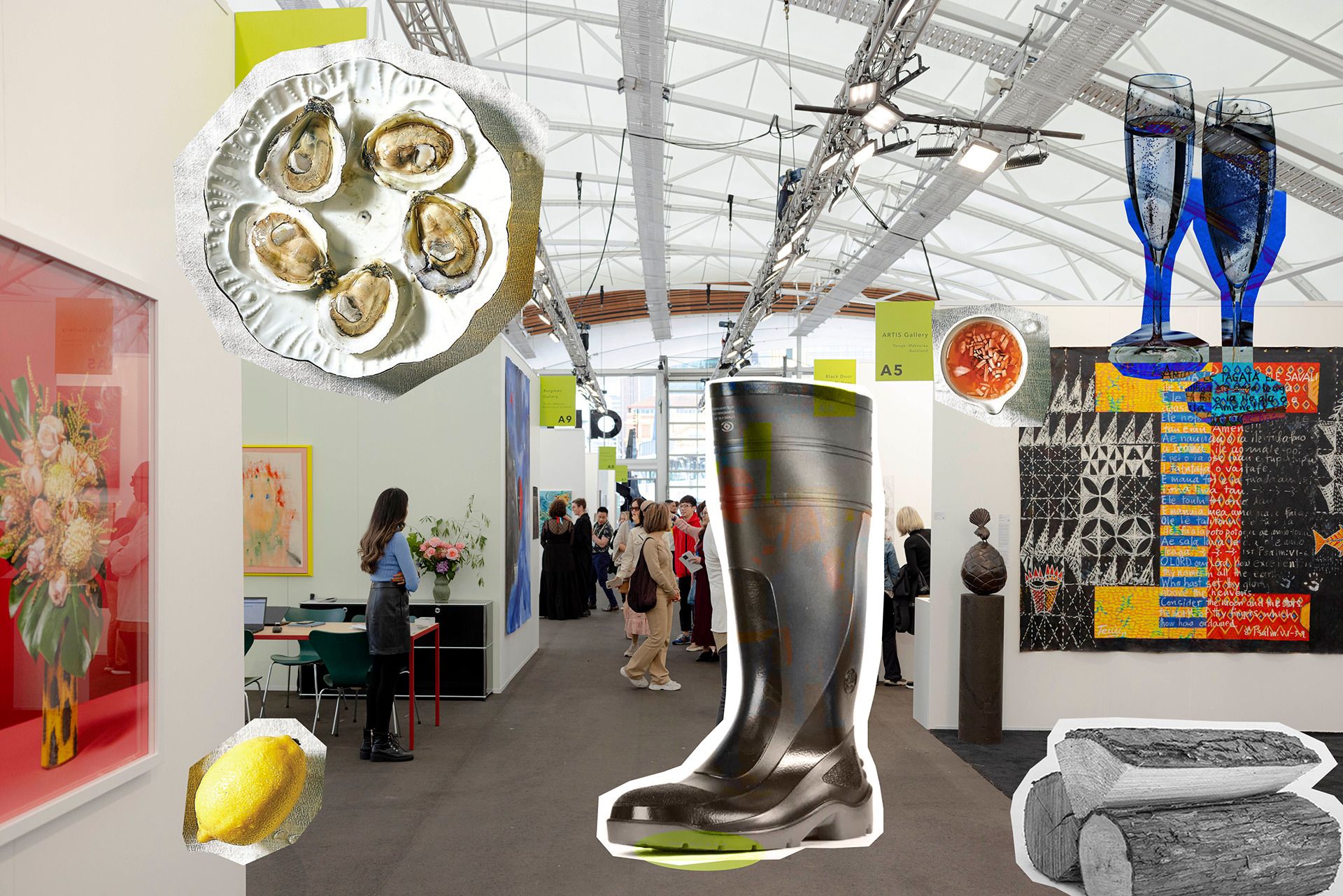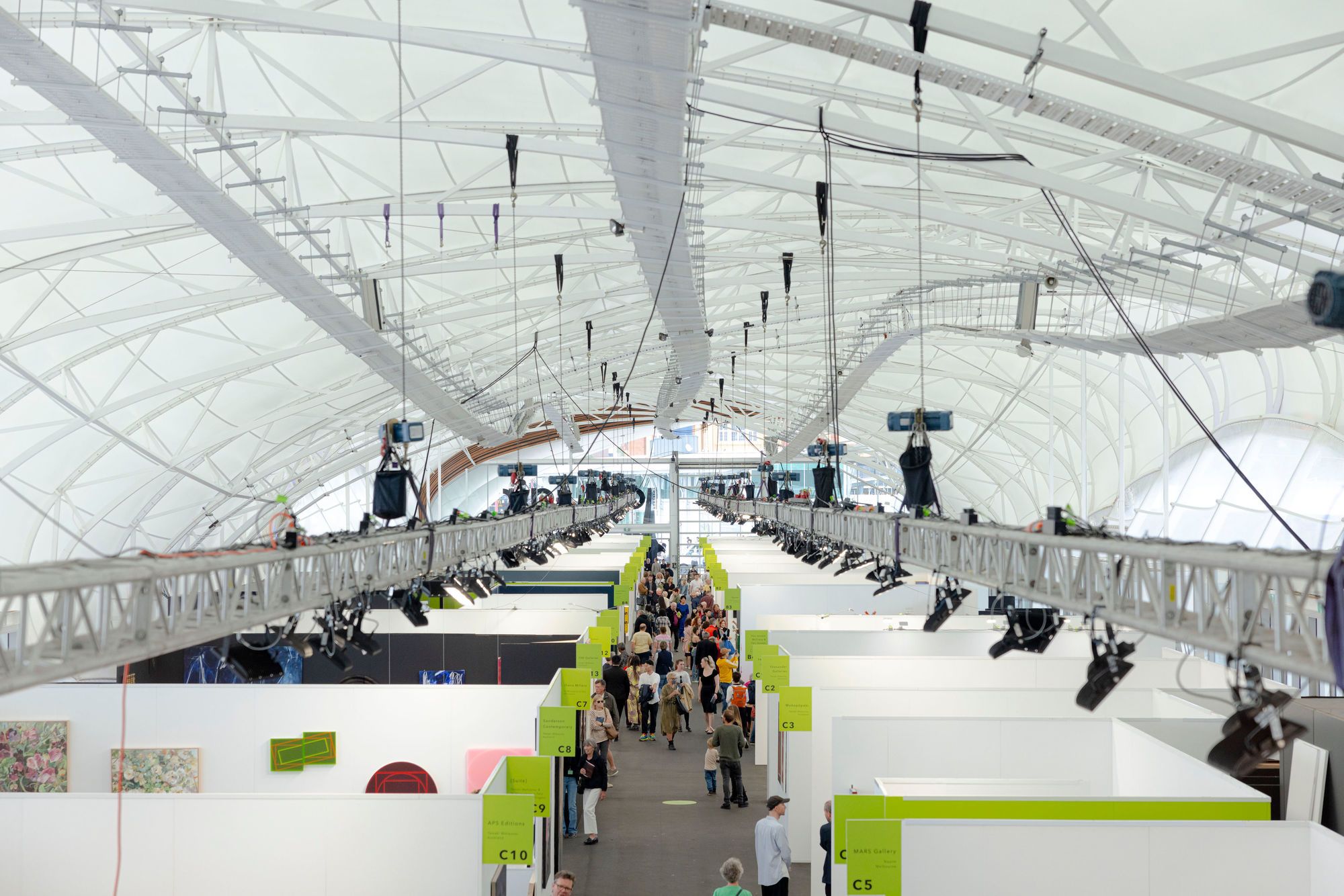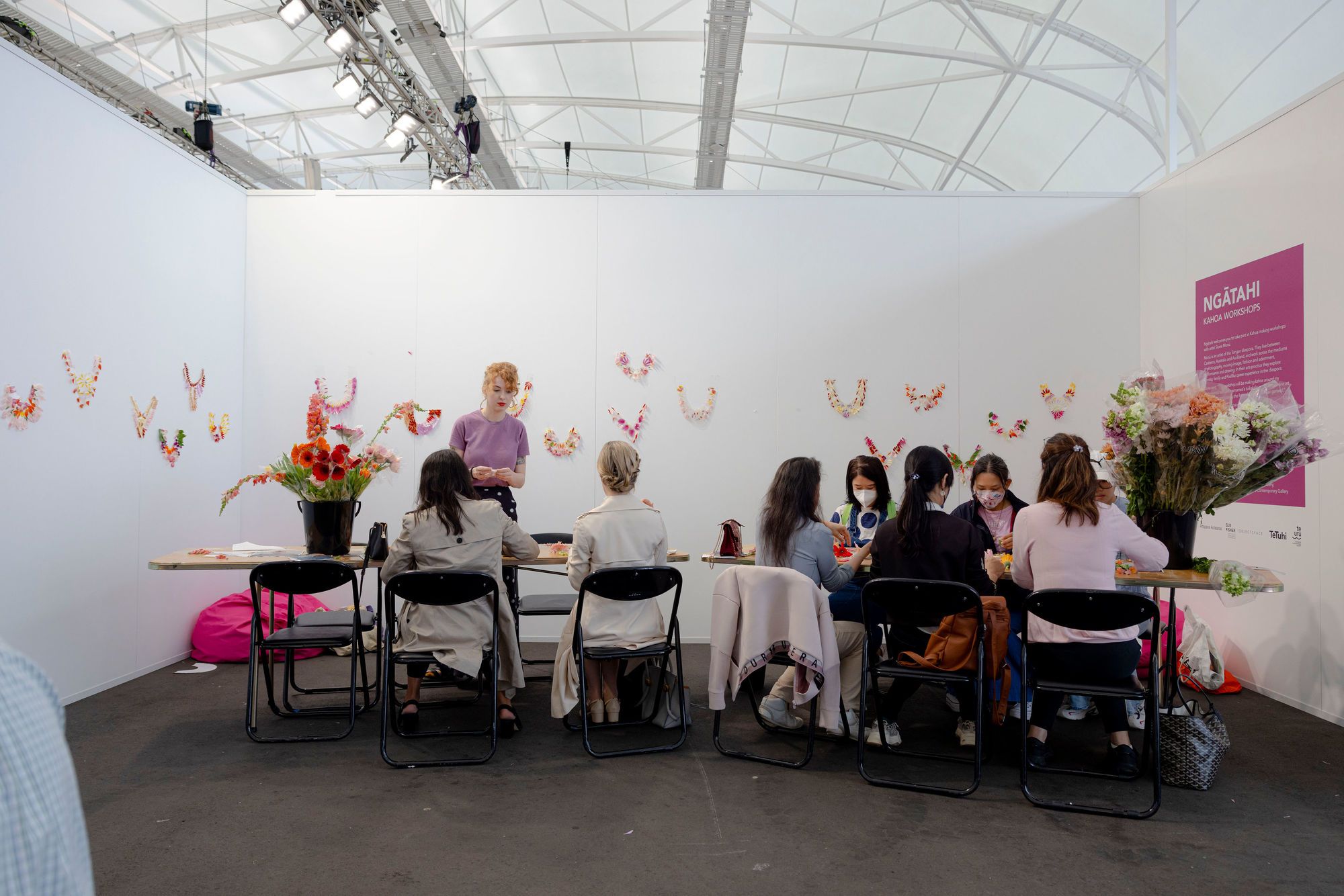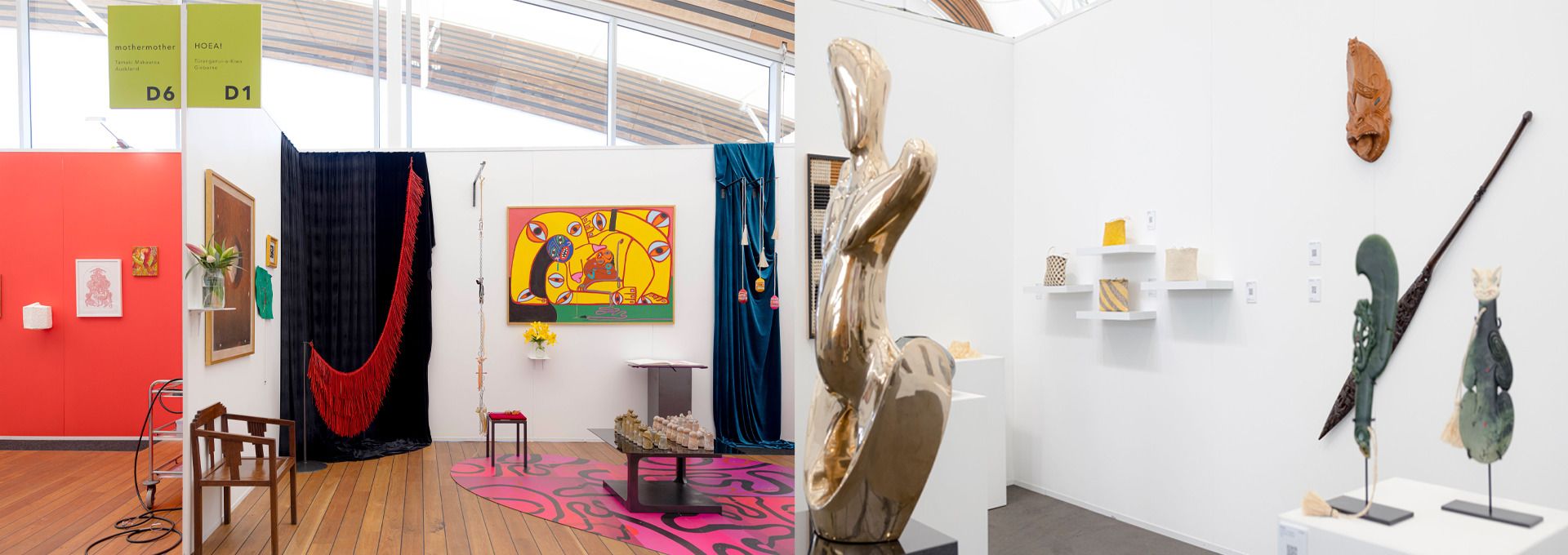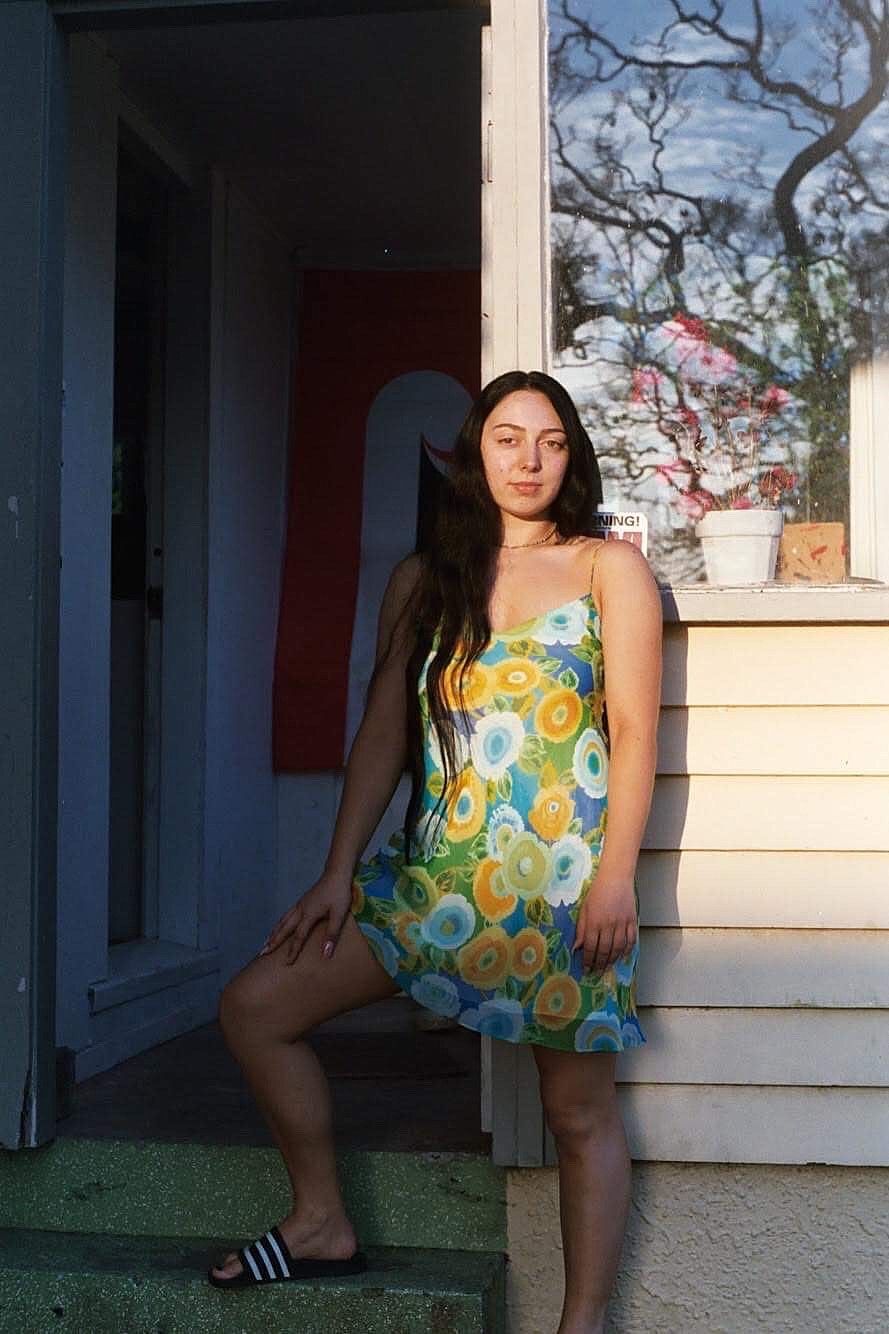Highlights and Reflections on the Aotearoa Art Fair
Mya Morrison-Middleton visits Aotearoa’s largest contemporary art showcase, wrestles with the tension of art as money-making, and recaps her faves.
In November 2022, the Aotearoa Art Fair opened the doors of The Cloud on Tāmaki Makaurau Auckland’s waterfront for paying visitors to experience, and purchase, works from a selection of national and international dealer galleries. This year’s fair has been a while coming, with cancellations earlier this year due to alert-level settings.
I went to the Art Fair as a participant in a free workshop on curatorial practice, run by Heather Galbraith, Zoe Black and Balamohan Shingade. Along with entry to the workshop came a VIP pass, and I was excited to be a fly on the wall at a bougie event. I packed a nice dress, boarded the plane to Tāmaki Makaurau from Ōtepoti, put on ‘Every Hori is a Star’, by Mara TK feat Troy Kingi, and prepped for champagne, glitz and seeing people again that I’ve earnestly missed.
2022 Aotearoa Art Fair. Photo by Luke Foley-Martin.
On the first day I was, naively, startled by the retail set-up. It’s an art fair after all. But seeing accomplished artists’ works tacked up on temporary walls in an art supermarket was still a shock.
The commerce was hard for me to reconcile. I left on the first day with mixed feelings about the art industry. I was amazed that people can afford a $20,000 artwork in this economy, but also felt envious and empty, imagining these artworks living in a hotel lobby or a Herne Bay lounge, carted off to wealthy collectors, far out of reach of the general public. It left me unusually grateful for the, still limited, access offered by public institutions to experience artworks.
Expecting artists to survive on the frugal fees offered by nonprofits and public galleries and museums is unrealistic at best and toxic martyrdom at worst.
However, expecting artists to survive on the frugal fees offered by nonprofits and public galleries and museums is unrealistic at best and toxic martyrdom at worst. And when artists and art workers make money, most of their income goes back into supporting each other, anyway. I mentally drafted up models for how commercial practice could function: where artists live well, and art has an impact beyond the wealthy. Is the answer selling more artworks in the (relatively!?) affordable under-$2000 price bracket? Do we need governing bodies to step in with regulations to ensure artists are being paid fairly? And for the wider industry: Is this all the result of the high cost of living in this country? Do we as a country over-expect free access to art? These persistent issues are new to this whenua – prior to the big C of colonisation, hapū would have sustained the people who wove the kākahu and tukutuku. Then again, maybe, it’s not that deep.
To call all art commerce bad and exploitative is a cliché, but the scale of money moving at events like the Aotearoa Art Fair is far from the world of funding grants and fees that I live in. To put it in perspective, the last 2022/23 Creative New Zealand Arts Grants round funded 52 grants totalling $2,202,913, and the latest CNZ Annual Arts Grants funded 23 grants totalling $2,832,339. CNZ is currently the nation’s main source of public funding for independent artists. Yet, in the four days of the 2021 art fair 38 galleries sold over $10 million worth of art and averaged $333,405 worth of sales per gallery. Artists would have only taken a portion of that $10 million. The industry standard is often a 60/40 split on sale price, with artists coming away with 60%. But it remains an unregulated industry, dependent on the agreement between the gallery and the artist.
The amount of money moving into the pockets of artists at the fair, after any cut taken by the galleries representing them, is still 100% more than what is paid to artists on the secondary market, such as auction houses. Artists on the secondary market aren’t entitled to any proceeds from sales, which various advocacy groups including Arts Makers Aotearoa brought to public awareness last year. This will change with the soon-to-be-established resale royalty scheme, which will give artists a 5% cut when their works are sold on a secondary market (hopefully in 2024!). This means that when someone goes to resell an artwork, often for more than they paid initially to the dealer/artist in the primary market, a percentage of the sale price is given back to the artist. That 5% isn’t much but it matches up with standard international practice, and has been hard fought for!
Kahoa making workshop led by Sione Monū on the Ngātahi stand at the 2022 Aotearoa Art Fair. Photo by Luke Foley-Martin.
Looking beyond profit margins, Aotearoa Art Fair has attempted to expand its free offerings. These included the small curatorial workshop I attended, and a similar writing workshop, initiated in 2021. Also in the mix were kahoa-making workshops with sweetheart artist Sione Monū, and the Govett-Brewster programmed a series of artist and curator talks on topics like Contemporary Art For Our Time: Creating Works of Significance, alongside pop-up artist’s talks and public sculptures.
Expanding the dealer universe of the fair was the newly formed He Iti project featuring smaller dealer and non-commercial galleries from across Aotearoa and Australia. He Iti featured powerhouses and gallery wairua boosters Hoea!, all the way from Tūranga-nui-a-Kiwa. Hoea! showed work from artists within their recent programme, such as George Watson with her industrial whītau (Kāi Tahu mita for muka), metal and beeswax ribbon hangings, Piupiu Maya Turei’s celestial wai ū hei tiki prints, and Michelle Hinekura Kerr’s infinite red silky strands of pokinikini. Hoea!, who opened as a gallery last year, offered an unconventionally warm, interesting and welcoming booth installation with draped velvet hangings and a giant love-heart tile.
Hoea!, who opened as a gallery last year, offered an unconventionally warm, interesting and welcoming booth installation
Alongside Hoea!’s refreshing Māori artistry, Toi Māori Aotearoa showed Lewis Gardiner’s potent pounamu and whalebone weaponry, Sonia Snowden’s superstar kete whakairo and Rānui Ngārimu’s luscious houhere bark vessel, among other ringatoi Māori. My heart broke the second day when I saw a red dot next to Ngārimu’s work – at $767 it was probably one of a few things (except for books) that I could have afforded. This is the first year Toi Māori Aotearoa have had a stall at the fair, and what a success to see such a strong toi Māori contingent.
L: Installation view Hoea! Gallery stand at the 2022 Aotearoa Art Fair. R: Installation view Toi Māori stand at the 2022 Aotearoa Art Fair. Photos by Luke Foley-Martin.
Also breaking the art-supermarket exchange was the project Aotearoa Made,curated by Michael Do, which included four new works commissioned by the Chartwell Trust and installed at the fair but not listed for sale. A highlight was Miranda Bellamy and Amanda Fauteux’s slew, slough, slue, a stall constructed from refurbished kahikatea timber topped with butter sculptures. Kahikatea were cleared to make way for dairy-farming paddocks, and milled to create odourless boxes for transporting butter. The work responded to the fair’s location on Queens Wharf, where butter was first exported in these kahikatea boxes, collapsing the time between the pioneer industry of then and the resulting ecological state and export industry now. The pre-moulded butter sculptures melted with the warmth of moving bodies, sun and sales. Other memorable works at the fair included Lonnie Hutchinson’s series of colourful steel combs with cut-out taro leaves and bird silhouettes; Atong Atem’s large prints of self-portraits from her series Surat; Turumeke Harrington’s glowing coloured sconces, filled with constellations of tuna, hares, tī kōuka and stars; Stevei Houkāmau’s threaded chains of uku seeds, detailed with precise carved patterning; and Jude Te Punga Nelson’s pristine and sublime whītau kete.
L: Installation view of Bellamy and Fauteux’s, slew, slough, slue, at the 2022 Aotearoa Art Fair. R: Atong Atem speaking about her work on the MARS Gallery stand at the 2022 Aotearoa Art Fair. Photos by Luke Foley-Martin.
L: Stevei Houkāmau speaking about her work on the Masterworks Gallery stand at the 2022 Aotearoa Art Fair. R: Installation view of The Central’s stand featuring works by Lonnie Hutchinson and Simon Edwards at the 2022 Aotearoa Art Fair. Photos by Luke Foley-Martin.
Tickets opened up to the general public on the second day, for a relatively more affordable price of $27, and I realised the sheer number of people who engage with art in a commercial setting. Perhaps because the exchange between audience and art is clear; either potential buyer or window shopper. The fair is loud and lively. People are strolling around with coffees, laughing. It’s not the intimidating quiet and sterile gallery environment. The trade-off is the loss of sensory exhibition-making and display, because the temporary walls and carpets are a reminder that you are still at a trade show – just swap the gumboots and wood-chopping competitions for oysters at three for $18.
On the flight home my feelings on the fair softened. The big ethical tug-of-war happening in my head put friends, artists, gallerists and artworks as players and bystanders on a swampy field. It’s unfair and sticky; the tough competition between artists in nonprofit arts funding, paying mortgages and the cost of living. We’re all scrambling at various rungs of the ladder, and I will definitely go to the art fair again if I get another free pass.
Aotearoa Art Fair 2023
Thu 2 – Sun 5 March
The Cloud, Tāmaki Makaurau Auckland
Header image: 2022 Aotearoa Art Fair. Photo by Luke Foley-Martin. Collage elements by Pantograph Punch.
